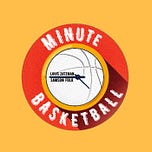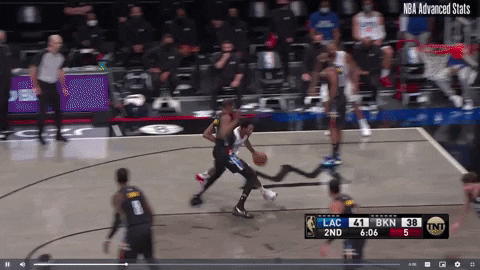The sky was bluer yesterday in Toronto than I remembered it could be. That’s the thing about the winter; you forget things like the sharpness of the sky and the air. This winter, especially. It’s not just the month of February, with crusted black snow in every direction, and daylight only starting to creep back out of its hole. It’s also the pandemic, of course. That makes you forget, too. The pandemic gets into everything like the first frost gets into last summer’s garden. Everyone I know right now is feeling the same way: a universal synchronicity despite and because of our mutual isolation.
All that to say, it’s nice sometimes to notice the colour of the sky. It’s nice to have an outlet.
The NBA is that outlet for a large many of us. This year is a little different, yes. It’s popular to argue that the NBA shouldn’t be playing games right now, though for my money, it’s safer for players to be in their semi-bubbular environments than not. The NBA has always been a goliath, money-churning slaughterhouse, and if it took a global pandemic to dash your optimistic view of This League, well, then I don’t know what to tell you. Your outlets don’t have to be morally flawless, even in the stark light of day.
What fools we are at Minute Basketball to try to monetize our outlets. (Or, in the case of Minute Basketball specifically, very much not doing that.) An entire generation decided out of necessity, boredom, and the lust for purpose to monetize its hobbies. We’re like elderly sewers who sell our mittens at market, but instead of serging fabrics we have Google Docs and Twitter. We youths, too, get paid less than minimum wage as we scroll towards the ruin of our outlets. Fun!
Outlets are also an integral part of basketball itself. They’re types of passes, keys for single offensive possessions. Or to zoom out, keys to entire seasons; a knock out, a plug in.
This week in Minute Basketball: Outlets.
Folk - Plugging In
The building I live in is very old. So old, in fact, that I’ve had to purchase adapters for every single three-pronged electrical ‘pluggy thing’ that I own, because when the outlets were installed no one had yet conceived of a laptop charger that would be rendered useless in the face of two slits in a plastic casing, buried in cement. The lamps are wired directly into the wall. I wasn’t kidding my guy. So, anytime I get to plug something in that isn’t three-pronged, but instead the standard two, it is a small relief that I don’t have to locate my adapter. That made me think about how nice it is when things just fit, and by extension, that made me think of Nicolas Batum, the Clippers, and one of the NBA’s best offenses.
I’ve been a hardcore fan of basketball long enough that I’ve been able to notice as players come in and out of vogue. Oh, the days when Kentavious Caldwell-Pope represented a good return for the unpopular DeMar DeRozan, or when Batum was everything DeRozan wasn’t - and for some strange reason (maybe because the Blazers were Raptors-west?) they were often juxtaposed. Then, Batum quietly plateaued with the Hornets over 5 years and eventually provided such a poor return that the countdown began until his contract was up. He just didn’t look like an NBA player anymore.
There’s a different version of this player every year. Last year it was Dwight Howard. Mentality, fitness, something breaks right, and a contender picks up a borderline top-100 player off the scrap heap. This year, it’s Batum. A slow, intelligent offensive player to slide into the Clippers slow and intelligent offense. Only the Knicks and their (somewhat successful) legion of power forwards play slower than the Clippers this year.
The simple per game numbers have Batum at 30mins/10pts/5rebs/2.5asts/1stl on 50/46/84 shooting splits. He’s started every game, on the Clippers who are currently tied for the league’s best record at 16-6.
Batum will get a pin-down every once in a while (93rd-percentile spotting up), or a side pick n’ roll, and he’s an excellent player to have indulge in some second-side action. However, the majority of his value lies in his ability to morph into whatever the Clippers need on a given possession, or a certain game. When the Nets overloaded on Kawhi Leonard and Paul George in what might be a Finals preview, Batum slid along the outside of the arc to maintain spacing and to hit from deep. When his shot started going, they used him as a screener to dissuade the Nets from dropping low or hedging. They ran pin-downs to lift the defense away from where they would eventually find Leonard in the post. And when his defender was complacent, he would mosey to the bucket, cool as you like, and grab himself a quick layup. The ultimate tertiary piece.
Like a Canadian in a grocery store: “Just gonna skoooooch right by ya there.”
Some games he’s the trigger man in a multitude of set actions, in others he fades into the background. If George is burning the other team down, get back on defense and make your rotations, creep in the passing lanes. The same goes for if Leonard is eviscerating the opposing team. An amorphous blob of competence. He’s provided major efficiency in a number of roles, and should continue to do it as we creep closer to the playoffs. Who wouldn’t want a wing who’s in the 95th percentile in points per shot attempt, 87th in assist-to-usage ratio, and 78th in turnover-percentage? A reliable decision maker for his own team, and dangerous to the opposition.
I’m not sure if he’s the convenient two-pronged plug-in that requires nothing and provides what I need at the time, or if he’s the adapter that allows me to start plugging in things that require more power - a skeleton key of electricity. He’s probably both. And being able to do a lot of things at once, the simple and the complex, makes for a dangerous team when the games matter the most, and the least.
Zatzman - Knocking out
Basketball as an outlet is meant, above all else, to be fun. And there is nothing more fun in basketball than the outlet pass.
It also happens to be some of the winningest basketball there is. The outlet pass sparks the fire of transition basketball. Per Cleaning the Glass, the average transition offense scores 124.4 points per 100 plays, while the average half-court offense scores 95.8 points per 100 plays. Thus like the holy grail unlocks eternal life, the outlet pass doubles as an incantation to find easy scoring.
Take LaMelo Ball. He’s not the best player on the Charlotte Hornets, but he is certainly the most fun. And his ability to jump-start Charlotte’s transition attack through the outlet pass is artful. Ball is like a pitcher with a bag full of tricks.
Ball has, of course, the fastball.
He can slow the pace with his curveball.
He can bend the ball the other way by twisting his release, otherwise known as the screwball.
He even has the rarely seen eephus, basically a curveball that doesn’t curve, known only for its slow pace and high arc.
Ball doesn’t have to go high, of course. He can throw a slider in the dirt, too.
Behind Ball’s tools, the Hornets have thrived this year. Per NBA Advanced Stats, no team from last season to this has improved the frequency of their transition looks as much as the Hornets, who have added approximately 4.4 transition shots a game. And the Hornets are also second in the improvement of the quality of their looks, scoring 1.15 points per transition attempts this season versus 1.05 last year.
You know what else the Hornets have improved at? Winning. Last season, their win percentage was 35.4. This year it has crept upwards to 45.5. Ball isn’t the only reason why, but his chapter is a turning part of the story. Helping a team win is as rare for a rookie in basketball as the eephus pitch is in baseball.
That’s the value of the outlet pass.




















Share this post